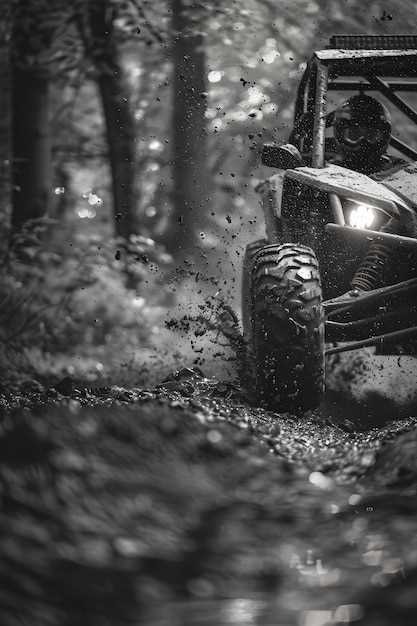
In the world of motorsport, rally racing stands out for its diverse terrains and unpredictable conditions. One of the pivotal components influencing a vehicle’s performance in these challenging environments is the tires. The design and material composition of rally tires play a crucial role in ensuring grip, stability, and safety, particularly when faced with extreme weather conditions.
Rally tires must be engineered not only to withstand the intensity of competition but also to adapt to rapid changes in weather. Various factors, such as temperature fluctuations, wet or icy surfaces, and loose gravel roads, necessitate a comprehensive understanding of tire dynamics. Designers must consider tread patterns that enhance water evacuation, rubber compounds that remain flexible in low temperatures, and sidewall structures that offer durability against rough terrains.
In this article, we delve into the intricacies of rally tire design, exploring the specific challenges posed by extreme weather conditions. By examining innovative technologies and materials, we aim to shed light on how manufacturers push the boundaries of performance to meet the exacting demands of rally racing.
Evaluating Rubber Compounds for Different Temperatures
When designing rally tires, one of the most critical factors to consider is the rubber compound used, as it directly impacts performance across varying temperature ranges. Different environments pose unique challenges, and the choice of rubber determines a tire’s grip, durability, and overall behavior on the road.
At lower temperatures, rubber compounds need to maintain flexibility to ensure adequate contact with the surface. Harder compounds may become brittle, leading to reduced traction and increased chances of tire failure. Therefore, compounds enriched with specific additives that enhance low-temperature performance are essential. These compounds often exhibit a more elastic characteristic, allowing them to conform better to uneven surfaces, thereby improving grip even in cold conditions.
Conversely, in high-temperature scenarios, rubber compounds face different challenges. Elevated heat can lead to increased wear rates and altered tire performance. Compounds used in warmer conditions generally feature a higher molecular weight, which enhances their stability and heat resistance. Additionally, incorporating certain oils can optimize the compound’s viscosity, ensuring the tire performs effectively without becoming too soft, which could compromise handling precision during aggressive rally maneuvers.
It is also important to consider the track surface when evaluating tire compounds. For example, a rally set in extremely cold and wet conditions may require a softer, more flexible rubber to ensure adequate grip. In contrast, hard-packed, dry surfaces in warm weather can benefit from a stiffer compound that provides better durability and reduces rolling resistance.
Ultimately, by carefully selecting and testing rubber compounds for different temperature ranges, manufacturers can create rally tires that not only withstand the rigors of extreme weather but also enhance the performance of rally vehicles. Continuous research and development, combined with real-world testing, are indispensable for achieving the optimal balance needed for specific rally conditions.
Understanding Tread Patterns for Mud, Snow, and Ice

Tread patterns on tires are crucial for enhancing performance in extreme weather conditions, particularly for off-road vehicles. Each type of terrain requires a specific tread design to optimize traction, stability, and handling. In muddy environments, deep, wide grooves create channels that allow mud to flow through and prevent the tire from becoming bogged down. This design helps maintain contact with the ground, ensuring better grip and maneuverability.
For snowy conditions, tires need a different approach. Tread patterns that feature numerous sipes–small slits in the tread blocks–allow for enhanced biting edges, which improve traction on slippery surfaces. Additionally, a more tightly packed pattern can help in compacting snow and providing stability. A balanced combination of grooves and sipes helps vehicles to maintain control while traversing snowy landscapes.
When it comes to icy surfaces, the importance of specialized tread designs increases significantly. Tires intended for ice must feature a solid center rib and fewer grooves, optimizing the contact area for grip. Studdable tires can further enhance safety, as metal studs protruding from the tread provide added traction on slick ice. This combination of features enables drivers to navigate icy roads while minimizing the risk of skidding.
In summary, understanding the specific tread patterns for mud, snow, and ice is essential for designing effective tires for extreme weather conditions. By tailoring the tire design to the surface it will encounter, manufacturers can greatly improve the performance of off-road vehicles in challenging environments.
Assessing Tire Pressure Adjustments for Off-Road Performance

Proper tire pressure is crucial for maximizing off-road performance, especially in extreme weather conditions. Adjusting tire pressure can significantly influence traction, handling, and overall stability. Lowering the pressure increases the tire’s footprint, allowing it to conform better to uneven surfaces and providing enhanced grip on loose terrain, such as sand, mud, or snow.
Conversely, increasing tire pressure can be beneficial in rocky conditions, where a harder tire can avoid punctures and improve stability on sharp obstacles. It’s essential to consider the specific off-road environment and the vehicle’s demands when determining the optimal pressure. A general rule of thumb is to start with the manufacturer’s recommendations and adjust according to real-world testing.
Moreover, the choice of tires also affects how pressure adjustments influence performance. Tires designed for extreme weather conditions often feature specialized tread patterns and rubber compounds that react differently to varied pressures. Experimentation is necessary to find the ideal balance between flexibility for traction and firmness for protection.
Regular monitoring of tire pressure, especially before and during off-road excursions, ensures that adjustments drive performance enhancements effectively. In extreme weather conditions, even a small deviation from the recommended tire pressure can lead to significant changes in handling and safety. Therefore, understanding the dynamics of tire pressure adjustments is essential for serious off-road enthusiasts seeking optimal performance.



